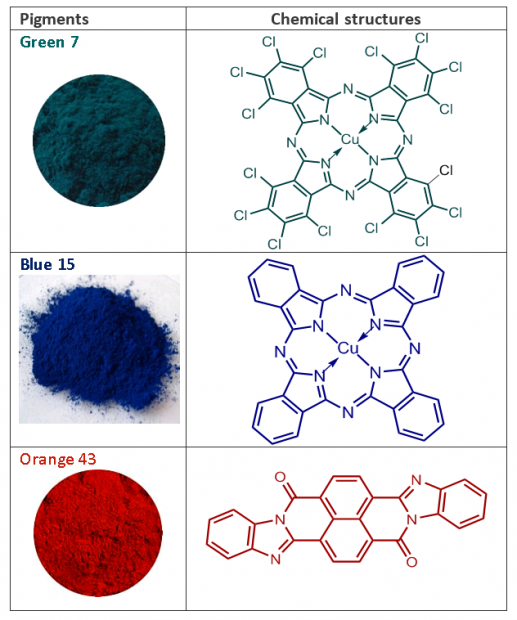 Nowadays, more and more people are interested in getting tattoos for different reasons: for attention, self-expression, spiritual or religious reasons, as a reminder of a family member, etc. But how many of them are interested in the composition of tattoo inks and what they can do to their health and their skin? According to a recent report by the Swiss Federal Office of Public Health, more than 50% of color tattoo inks (based on 206 color tattoo samples) do not conform to regulatory requirements.
Nowadays, more and more people are interested in getting tattoos for different reasons: for attention, self-expression, spiritual or religious reasons, as a reminder of a family member, etc. But how many of them are interested in the composition of tattoo inks and what they can do to their health and their skin? According to a recent report by the Swiss Federal Office of Public Health, more than 50% of color tattoo inks (based on 206 color tattoo samples) do not conform to regulatory requirements.
Composition of Tattoo Inks
Tattoo inks are composed of two main components: the carrier and the pigment. However, they often contain mysterious additives and impurities.
The Carrier
The carrier is the medium in which pigments are dissolved or suspended. It is composed of two ingredients: a binding agent and a solvent. The role of a binding agent is to hold together the pigment particles and to help distribute or suspend them in a liquid (solvent) that facilitates the injection of the ink into the skin. The most used binding agents in tattoo inks are polyethylene glycol (PEG), polyvinylpyrrolidone (PVP) and vinylpyrrolidone/vinylacetate (VP/VA) copolymer (see chemical structures in figure 1). These polymers are widely used in cosmetics and personal care products (hair or nail care). They are classified as "not expected to be potentially toxic or harmful".
Most tattoo inks use water as a solvent, but some polyvalent alcohols can be added in order to regulate the drying properties (ethanol, isopropyl alcohol), increase the viscosity (glycerin) and dispensability (propylene glycol). Glycerin and propylene glycol, for instance, are also widely used in medicine, cosmetics and even electronic cigarettes. These alcohols serves also as disinfecting agents, however, their concentration should be limited because they can irritate the skin.

Figure 1: Chemical structures of some binding agents used in tattoo inks
The Pigments
Pigments are responsible for the colors of tattoo inks. As the tattoos are supposed to be lasting or permanent, they are in general insoluble in a water-based medium, and should not be biodegradable after application. The pigments are classified into two main categories: mineral pigment (usually metal oxides or salts) and organic pigments (synthetic chemical substances such as azo dyes, some pigments contain both organic and metallic components (examples are shown in figure 2). There are a great deal of pigments available in the market, and some are officially approved. However, many are in fact not approved for skin contact at all. A list of prohibited pigments as well as limited concentration of some heavy metals in colors tattoo inks can be found on the Swiss Federal Office of Public Health’s website.
These pigments have been banned for a good reason: they are usually toxic, carcinogenic or allergenic. For example, the basic Red 9 (pararosaniline) is known to be carcinogenic and flammable.

Figure 2: Chemical structures of some pigments used in tattoo inks
Additives and impurities
Pigments can also contain toxic impurities depending on the manufacturing/synthesis process used to make them. Heavy metals like tin (Sn), cadmium (Cd), lead (Pb) or even arsenic (As) can be found in mineral pigments. The contamination with heavy metals is much lower in organic pigment compared to mineral pigments, but they might contain some very toxic compounds such as nitrosamines, primary aromatic amines or polycyclic aromatic hydrocarbons. These three types of impurities are known to be carcinogenic and in the long term, could cause skin cancer. This is one of the reasons why the regulation also includes standards for the purity of pigments used. Unfortunately, this information is rarely communicated by producers. Moreover, the additives used in tattoo inks are usually not declared. These additives or preservatives are used by producers in order to stabilize tattoo inks against UV degradation or bacterial contamination. According to a study by the Swiss Federal Office of Public Health, 14% of the samples analyzed containing unauthorized technical preservatives such as phenol, octylisothiazolinone or benzisothiazolinone.
It is, however, important to point out that these considerations on the toxicity of tattoo ink is based on the known toxicity of individual compounds. The tattooing process has its own particularities, and the effects of these dangerous chemicals injected in the epidermis are not yet well understood.
How to get a safe tattoo
Since the tattoo ink market is quite complicated, the producers are not required to reveal all of the ingredients in their inks. To further complicate things, the regulations are different from one country to another, making it hard for customers to know which ink is safe and which is not. Tattoo professionals are indeed responsible for the safety of their inks. They must have a basic knowledge about tattoo ink regulations, as well as some general rules when purchasing inks, and should regularly control their products to make sure they conform to industry standards and laws. According to the Swiss Federal Office of Public Health, they are advised to require from their suppliers a written confirmation that their products meet Swiss legal regulations. They should also ask the manufacturers for the Material Safety Data Sheets (MSDS) of each pigment or carrier, as well as analyses, certificates or other documents proving their products do not contain prohibited chemicals. Furthermore, it is highly recommended to purchase inks from suppliers with a solid reputation, and avoid any lesser known suppliers or those who could be risky.
Before "getting inked", ask your tattoo professional for health and safety information on the pigments and carriers to be used in your tattoo. Take a skin test with the inks (in order to avoid an allergic reaction). And of course, choose a professional with high hygiene standards (single use needles, sterilization equipment, clean and well ventilated environment).
Sources:
https://www.news.admin.ch/message/index.html?lang=fr&msg-id=56696
https://www.admin.ch/opc/fr/classified-compilation/20050181/201401010000/817.023.41.pdf
http://www.gef.be.ch/gef/fr/index/direktion/organisation/kl/publikationen/Informationsdokumente.assetref/dam/documents/GEF/KL/fr/infodoc_tatoofarben_1_f.pdf
http://ec.europa.eu/consumers/archive/cons_safe/news/eis_tattoo_proc_052003_en.pdf
Tattooed skin and health by J. Serup,N. Kluger,W. Bäumler (Current problems in dermatology, Vol.48)
Photos:
Tattoo: photo by Hoang Thi Nhu Y
Tattoo inks, licence: Wikicommon
Phthalocyanine_green, licence: Wikicommon
Phthalocyanine_blue, licence: Wikicommon
Orange Périnone, licence: Wikicommon


 Nowadays, more and more people are interested in getting tattoos for different reasons: for attention, self-expression, spiritual or religious reasons, as a reminder of a family member, etc. But how many of them are interested in the composition of tattoo inks and what they can do to their health and their skin? According to a recent report by the Swiss Federal Office of Public Health, more than 50% of color tattoo inks (based on 206 color tattoo samples) do not conform to regulatory requirements.
Nowadays, more and more people are interested in getting tattoos for different reasons: for attention, self-expression, spiritual or religious reasons, as a reminder of a family member, etc. But how many of them are interested in the composition of tattoo inks and what they can do to their health and their skin? According to a recent report by the Swiss Federal Office of Public Health, more than 50% of color tattoo inks (based on 206 color tattoo samples) do not conform to regulatory requirements.



Thanks for this nice article. It shows that you should really be aware of the possible effects tattoo inks might have - most people probably don't consider this before getting a tattoo.
This was a really interesting article, and shows that we do need to be careful before putting any form of chemical on our bodies. Thanks for showing that we can have fun getting a tattoo while being safe at the same time.
Its true lot of people just go for tattoos without really caring about these details, which can become a nightmare.
However, is it not the responsability of the federal health office to do a survey on tattoo operators and find out if they are in accordance with all hygienic standards ?
Are there no rules and regulations when someone wants to operate a tattoo parlor?
Hello Bruce,
I had the opportunity to meet Dr. Patrick Edder (Head of the Consumer and Veterinary Service in Geneva) to discuss this. In fact, the tattoo professionals are responsible for the safety of their inks as well as for their hygienic standards. The responsability of the Federal health office is actually, as you said, to verify if the tattoo operators respect the laws, meaning the regulatory requirements. Then, of course, there are rules and regulations to respect in Switzerland for tattoo professionals.
Very interesting subject, I think a lot of people are not aware enough about the possible consequences of it.
WOW!!!
This is a great article, very detailed. Furthermore, you managed to explain easily for people who are not native English speakers!
I thought I was paranoid enough with these kind of things.
I did a lot of research on my tattooist before reaching out to her. We discussed my project, and she said to me that we would have to meet before taking an appointment for me to see where and how she works. I found her very professional and responsible. However, it’s true that a lot of us choose to have tattoos outside the country because of the prices most of the time. Moreover, some of us don’t really care about safety.
I’m thinking about getting another one in the future. I think what people should do is stay with the same tattooist they have found, if of course they are satisfied, or know some from friends.
I wonder if people would think twice about getting tattoos if they knew all this information.